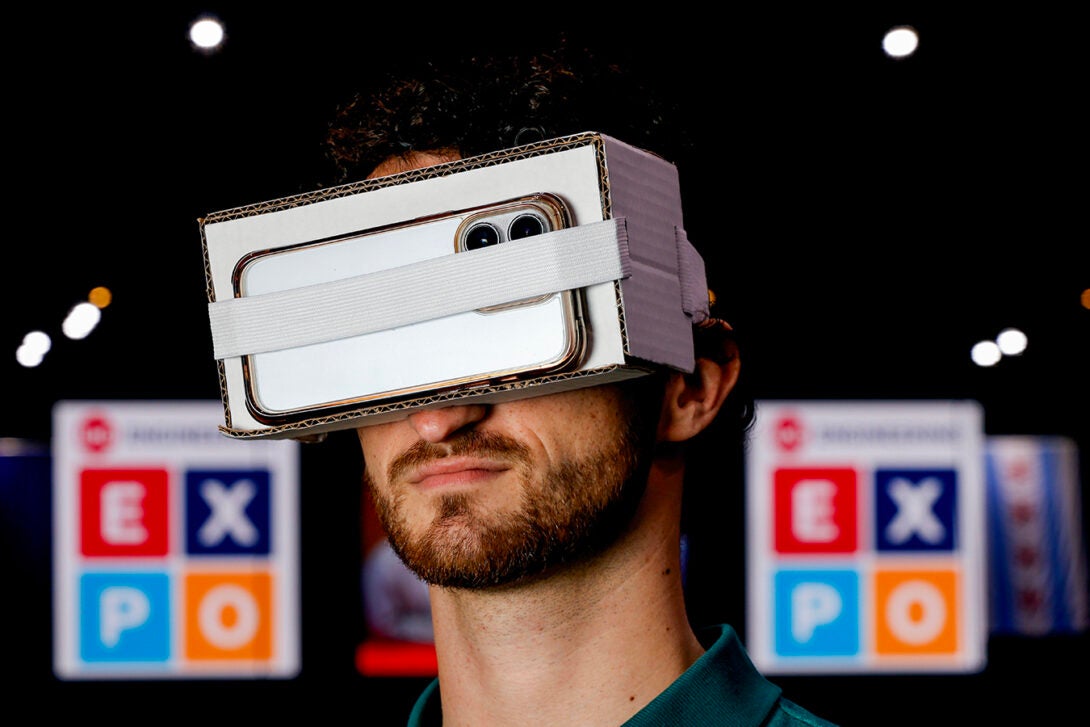Students show off ingenuity at expo
1

Mechanical and industrial engineering (MIE) students displayed their engineering creativity during the annual UIC Engineering Design Expo at the Credit Union 1 Arena on April 19.
The expo featured teams from across the College of Engineering who were challenged to solve real-world engineering problems as part of a required senior design course. More than 150 judges, including Chicago-area engineering professionals, alumni, and former COE faculty, participated in the event.
The student teams created a wide variety of projects including a repacking line, VR headsets, a portable meter, self-watering rain barrels, and much more. Learn about all the projects at Engineering Expo 2024.
1
Repacking Line for Long Tube Processing
Team 35, consisting of Mario Castrejon, Kenneth Chandra, Bryan Havens, Rashaun Muhammad, Badhrie Sridhar, and Emerald Warr, worked on a Repacking Line for their corporate sponsor Wieland.
Wieland, a metal production company, asked the students to explore the different aspects of a repacking line. The team created a production line that can transport metal tubes from storage to the line, process them for chamfering and/or cutting, repack them by banding the tubes and placing them in a crate, and finally unloading them into trucks for transportation.
The team determined the layout must be sequential and also incorporate room for skipping some steps within the process to meet customers’ specific demands.They used AutoCAD software to determine space and to ensure accuracy and flow within operations and the space surrounding it. Simio simulations were performed to simulate possible pathing options an operator and CombiLift can take and observe the process flow in its entirety. The students created and tested multiple design layouts to present to Wieland and determine the optimal layout for the needs they require.
1
VR Headset
Team 19, consisting of Bashar Alajjo, Graeme Classen, Batool Elagha, Hazem Elghazoli, and Alfred Nazhiyampara, presented their VR Headset project.
The team designed and constructed a low-cost headset that leverages smartphones as an alternative to expensive virtual reality projection hardware. The core innovation revolves around developing of a smartphone harness that can be comfortably worn like conventional virtual reality headsets. The harness positions the smartphone screen within the user’s field of view to create an immersive virtual reality environment.
The manufacturing process uses readily available construction materials such as cardboard to ensure that the headset can be easily and economically produced, making it an ideal tool for a broad range of settings. This approach reduces cost while enhancing accessibility for students and educators.
“Other headsets are very expensive and cost upwards of $400, and our headset cost us $4.18 and does the same job,” Alajjo said.
1
Portable Slurry Composition Meter
Team 17, made up of Harsh Chokshi, Charles Bell, Alfredo Garcia, Mohamed Hagar, Brennan Keane showed their Portable Slurry Composition Meter, was sponsored by United States Gypsum (USG).
USG is one of the largest distributors of wallboard and gypsum products in the U.S. and tasked the team with developing a portable battery-powered device to assist in determining the viscosity of a joint compound.
The team designed a hand-held device with a user-friendly interface and a spindle that provides a value when it is inserted into the joint compound mixture. The measured value is used to determine the viscosity and the features of the mixture. The final design will be easily transported in a backpack and weigh less than 20 pounds.
“We have a provisional patent that has been accepted and names us as inventors,” Hagar said.
1
Smart Eco-Friendly Consumer Lawn Irrigation Device Using Harvested Rainwater
Team 38, consisting of David Podstawski, Kamile Dirzys, Panos Malamis, Gerda Andriuskevicius, and Ashley Roman presented Smart Eco-Friendly Consumer Lawn Irrigation Device Using Harvested Rainwater to the judges.
The project’s goal is to manage water sustainability with a water collection system, which encompasses rainwater harvesting, water management, and the dispersion of water.
The students designed a system to provide a sustainable way to water lawns and gardens. The system collects rainwater in a 55-gallon rain barrel and then automatically waters the lawn three times a week. In addition to eliminating the use of public water sources, it automatically turns on and off for a set duration, eliminating the risk of overwatering. The system also uses solar power to keep it off the grid, creating a green and self-sustaining irrigation system.
“You can adjust the range and distance to any shape lawn, so you don’t throw water on your neighbors’ yard or fence,” Malamis said. “It will be controlled from an app later on.”